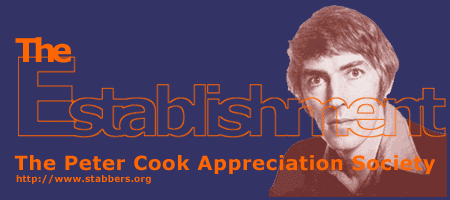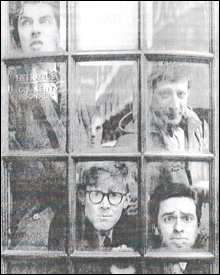|
Peter Cook, where the fuck do you start? Well, lets
get the facts down - born 17 November 1937 died 9 January 1995.
Married three times, first to Wendy (1964), then Judy (1974) and
finally to Lin (1989). Two daughters by his first marriage (Daisy
and Lucy) and a step-daughter from his third (Nina).
What does that tell us? Well, bugger all really,
but it's a start. Peter Edward Cook was born in Torquay, Devon to
Alexander and Margaret Cook. Alexander came from a long line of
civil servants in the diplomatic services, a tradition Peter was
fully expected to follow. He was educated at Radley College and
went up to Pembroke College, Cambridge to study languages in the
full expectation that he would eventually be packed off to foreign
climes to help administrate Britain's fading Empire. It was while
at Cambridge that he auditioned to join the prestigious "Footlights
Review". The Cambridge Footlights were the University's players
and actors, who would put on shows replete with straw boaters, merry
sing-a-longs and terrible puns. Cook and his generation were to
change this forever, making it, for a while at least, the breeding
ground for the foremost names in British comedy.
Cook's audition piece was a character he brought
with him from Radley, Mr Boylett, later to be retitled Arthur Grole
and more famously, E.L. Wisty. Mr. Boylett was a mesmerically dull
figure, a strange, other-worldly character in raincoat and hat,
obsessed with matters cosmic, mundane and absurd. The real Boylett
was a college servant at Radley. Cook was enormously entertained
with this massively dull, or incredibly dry man, who once claimed
to have sold a stone in the school drive-way because "I thought
I saw it move." Boylett became the Cambridge's favourite comic character
and adopting the Boylett nasal drone and catchphrases became widespread.
By the time Peter left Pembroke he was the star
of the Cambridge Footlights scene, and while he still paid lip service
to the foreign service he now seemed destined for a future in comedy.
After leaving the university Peter stayed in Cambridge for a while,
still contributing to Footlights revues, and beginning to make something
of a name for himself as a writer, including penning sketches for
two highly successful West End revues starring Kenneth Williams,
namely Pieces Of Eight (1959) and, later, One Over The
Eight (1961) [See P&B #12].
Included in the second of these shows was a sketch from one of his
Cambridge revues called One Leg Too Few, in which a one-legged
man auditions for the part of Tarzan. It was a masterpiece, written
by Cook when he was 18 years old and, he claimed to his dying day,
he never wrote anything better.
Cook's big break as a writer and performer came
in 1960 with a show called Beyond The Fringe. The idea of
the show was to combine four raw young talents from the cream of
the Cambridge and Oxford revue scene. To this end Cook was united
with Jonathan Miller, a doctor, Alan Bennett, a medieval historian,
and Dudley Moore, a fine jazz pianist and musicologist [See
P&B #16]. Between them they created a show that was
stark, sharply satirical and, for it's time, distinctly confrontational.
There were no gaily painted sets, no dancing girls, no jolly boating
songs, none of the then-traditional trappings of the revue. Four
young men in jackets and pullovers delivering the sharpest new comedy
around, including Cook's famous impersonation of Harold Macmillan,
the first time in living memory a current Prime Minister had been
directly mimicked and mocked on the stage. After an initial tepid
response , the show rapidly became a huge hit, transferring from
Edinburgh to London, via the English provinces, in 1961, and eventually
to New York in 1962. It ran, with various cast changes, until 1964
and lead to Cook, along with Miller and Moore, recording an album
with two of Peter's heroes, Spike Milligan and Peter Sellers, called
Bridge On The River Wye (1962) on Parlaphone.
Cook also found time to start up The Establishment
Club in Soho, London in 1961 with business partner Nick Luard.
The forerunner of so many later comedy clubs, The Establishment
was home to the latest performers to come up in the self-consciously
titled 'Satire Boom' started by Beyond The Fringe. The sweaty,
smoky club was packed to capacity every night and offered punters
the chance to see the latest talents to rise from Oxford and Cambridge,
along with acts from America such as the notorious Lenny Bruce,
and old-style British comedian and stand-up genius Frankie Howerd.
It was a roaring success, and a branch was opened up at The Strollers
Nightclub in New York in 1963 [See
P&B #11-12].
In addition to all this, Cook and Luard bought
controlling shares in the struggling satire magazine Private
Eye in 1962, the beginning of a lifelong association between
Cook and the magazine [See
P&B #15]. He operated a distinctly 'hands-off' editorial
policy, giving The Eye's editors free-rein to cover what
they wanted. Over the years his main contributions to The Eye,
aside from streams of one-off jokes, were the introduction of the
famous speech-bubble covers (an idea he got from an American magazine),
a couple of running series, some of which have been re-printed in
Publish & Bedazzled [#12
- 19 The Seductive Brethren, #20-
Rhandi Phurr], and recording various Private Eye flexi-discs
over the years, now available on the Golden Satiricals tapes. His
main contribution, however, was to keep the Eye staff's morale going,
injecting the magazine with an abundance of energy and raising cash
for their increasingly-frequent legal battles, all of which helped
to ensure that The Eye was about the only product of the
early '60s satire movement to out-live it.
While in America, Cook received disturbing news
about the state of affairs back home. Firstly the original Establishment
Club had lost a great deal of money on a lifestyle magazine,
Scene, and had also been over-run by the Soho gangster community
and was going downhill fast. Secondly it appeared that someone else
had taken one of his ideas and was using it to usurp Cook's position
back home as the leader of the new satire movement. Before leaving
for the States, Cook had decided to try his hand at pitching an
idea for a television series to the BBC. It was to be a weekly,
up-to-the-minute satire show based around his Establishment Club
and using the latest young talent. The BBC turned the idea down,
but accepted a very similar one from producer Ned Sherrin, minus
The Establishment. The show was to be titled That Was The Week
That Was, or TW3 for short, and it was hosted by one
David Frost. Frost had been a few years behind Cook at Cambridge
and quickly became friends with him and followed Cook into performing
at the Footlights. While every potential comedian at Cambridge at
the time was deeply influenced by Cook, many considered Frost's
act to have passed over the boundary into plagiarism. By the time
Sherrin approached Frost about TW3, the latter was performing
on the London circuit doing a suspiciously familiar impression of
Harold Macmillan. TW3 first broadcast in 1963 and quickly
became a huge hit. While Cook may have been the king of the satire
movement for those in London and Cambridge who were in the know,
Frost was going out to television sets around the country on a weekly
basis.
Beyond The Fringe ended its American run
in 1964 and Cook returned to Britain, now married to Wendy Snowden,
his girlfriend since Cambridge, to find his club all but finished
and what he thought, with some justification, was his idea for a
television series having been stolen, made into a huge hit and hosted
by a man Cook now referred to as "The Bubonic Plagiarist". The satire
movement on which Cook had built his career thus far was rapidly
diluting itself. Cook's career experienced a brief lull before the
opportunity to re-invent himself as a television comedian when he
was re-united with a colleague from Beyond The Fringe, Dudley
Moore.
go to
part two
|


